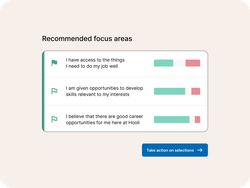
Do's & don'ts of encouraging engagement survey participation

Written by

Senior People Scientist, EMEA, Culture Amp
In order to get the most from your organization’s engagement survey, you want to get as many responses from your team as possible. A high participation rate ensures that results represent the department or organization. It also provides the best opportunity for actionable insight.
What is a "good" participation rate for an engagement survey? We would typically suggest 65-85% depending on your organization's size.
Encouraging higher participation isn't a bad thing to strive for. However, if you're not reaching your desired participation rates despite your effort, there's a chance that you're doing or saying something that is having an unintended impact on your team's participation.
With this in mind, we've compiled a list of "Do's" and "Don’ts" to encourage survey participation from your teams.
Do's and don'ts of encouraging survey participation
Do:
- Emphasize confidentiality and data security in the survey process
- Outline how feedback will be reviewed and the approach for taking action
- Emphasize the (short!) time commitment needed to complete the survey
- Explain features important to your team’s willingness to participate
- Role model the behavior you're seeking
Don't:
- Ask people directly if they've taken the survey yet
- Inadvertently reference how you would like participants to respond
- Suggest that the survey is all about you as the manager
- Forget to remind your team when the survey closes
Now, let's look at each do and don't in detail.
Do's for encouraging survey participation
1. Emphasize confidentiality and data security in the survey process
Your survey launch communications should explain how data will be processed, stored, and shared. However, when reminding your team that the survey is open and ready for their feedback, it's helpful to emphasize what measures have been taken around confidentiality.
For people to feel secure giving honest feedback, they need to know that their responses are confidential. They must trust that their data will be handled responsibly and that you, as a manager, are not going to be able to see their individual responses.
Reassure people that you’re not looking to single out their feedback individually by sharing that:
- Only aggregated data will be received by their manager
- Groups will only be identifiable down to your organization's agreed minimum group size
It can help to show people what level of results you and other team members will be able to see in the system. This isn't possible in every software solution or platform, though Culture Amp does offer that capability.
2. Outline how feedback will be reviewed and the approach for taking action
Research shows that people's willingness to give feedback in engagement surveys is impacted by their confidence that action will be taken. It's important that your team knows how data will be used and how actions will be taken after the survey. If you've surveyed your team before, remind your team of the previous results and actions taken. Remember the "what’s in it for me" principle when referencing past actions the team may have benefitted from and how they stand to benefit in the future.
If you can emphasize the opportunity for your people to get involved with action planning and improvement initiatives – even better. This will help them see that their views are welcome and that the organization plans to take action.
3. Emphasize the (short!) time commitment needed to complete the survey
For most of us, anything that takes up time in a busy day is something to avoid. This is why it's important to emphasize the average time they will need to invest in the survey. For example, the standard 57-question Culture Amp engagement survey usually takes less than 10 minutes to complete.
Encourage people to block out 10 minutes during their workday to make tea or coffee and complete the survey.
4. Explain features important to your team’s willingness to participate
If there are things that are likely to significantly impact the response rate for your team, get ahead of them. Usually, things that impact a survey's ease of use or time for completion can be blockers.
For example, if your team includes people of different nationalities, communicating that they can take the survey in their own language may encourage participation.
5. Model the behavior you're seeking
Show your team how easy it is to participate in the engagement survey. Take the survey yourself and share your experience with your team. For example, share that, "It only took me ten minutes and was a welcome distraction from emails on a Friday morning!" or "I found the survey format really easy to use."
Don'ts for encouraging survey participation
Now for the flip side: what should managers strive to avoid when encouraging participation in their engagement survey?
1. Don't ask people directly if they've taken the survey yet
Asking a team member to confirm whether or not they have taken the survey yet may seem like an innocent enough question. Managers are used to driving performance and team results, including holding individuals accountable.
However, if people are required to share their participation status with you, this could compromise anonymity in small teams. Also, if they've chosen not to participate, they may feel uncomfortable explaining why.
Engagement survey participation is not mandatory. Remember, you’re not aiming for enforcement but encouragement. Forcing participation is dangerous for two reasons:
- It compromises the validity of responses. People forced to participate will be inclined to "click through" rather than actively participate. This will likely skew results.
- The participation rate itself can often tell us something meaningful about the level of engagement, particularly when re-surveying or pulsing over time.
What should I do instead?
Encourage your team to take part when the survey launches. After that, don't ask about individual completion status, but rather share a general reminder and encouragement for everyone on an ongoing basis during meetings.
For example, at your regular team meetings you could have a standing item that states:
"The engagement survey has been launched and closes on X Date. We would be most appreciative if you're willing to take part, as everyone’s voice is important. We're keen to understand everyone’s thoughts so that we can both celebrate successes and identify areas of opportunity for improvement."
For people working shifts or on very tight deadlines, it's worth proactively carving out time for them to complete the survey.
Additionally, you can set up system reminders that will go out to those who have not participated. In that sense, your software or solution will chase individuals on your behalf. The Culture Amp platform, for example, sends reminders to those who have not yet participated.
2. Don't inadvertently reference how you would like participants to respond
As managers, we often want to emphasize why participating in an engagement survey is important. In our efforts to be persuasive and encourage participation, we may inadvertently bias responses negatively or positively.
For example, asking your team to be "brutally honest" in their feedback may be done with good intent (i.e., to encourage constructive criticism). However, it suggests that you're looking for negative feedback. It can also imply the assumption that there are negative themes that they should uncover. This can skew your team’s responses toward the negative end of the spectrum.
On the other hand, asking your team to "show everyone how good we are" primes your team to demonstrate (possibly false) positivity to the rest of the organization.
What should I do instead?
You should keep your language neutral and avoid referencing anything about how people should respond. You want to ensure that people respond in the manner which most accurately reflects their personal views and interpretations.
When selecting your language, a good rule of thumb is to use words that can apply to both good and bad news. For example, "honest" instead of words that evoke emotion, such as "brutal."
3. Don’t suggest that the survey is all about you as the manager
As managers, we're all keen that the teams we lead are engaged. However, you mustn’t over-emphasize the survey in relation to yourself. After all, the engagement survey is a means of collecting feedback on overall engagement, covering a wide range of factors. It is not 360 feedback on your own performance.
That said, there will likely be feedback that all team managers will have to act on and improve. However, the process is about participants’ views on engagement overall, so try to encourage participation impartially. Don't reference the potential impact the survey could have on you personally, as it can influence your team's willingness to participate and the extent to which people will provide commentary.
What should I do instead?
Present the opportunity to participate factually and non-emotionally. Remind your team that this is an opportunity to provide feedback on all aspects of the organization. Encourage active participation without reference to yourself or your own needs.
4. Don't forget to remind your team when the survey closes
Don’t just tell your team when the survey opens and expect them to take note of the closing date. Equally, don’t over-rely on one method of communication to ensure your team has got the message. Email is great for sharing links, but don’t miss the opportunity to remind your team at your regular meetings.
What should I do instead?
Communicate consistently by repeating information about the status of the survey and how long they have left to participate via multiple communication channels. Think about communicating in a way that makes sense for your team. For example, if you use WhatsApp or Slack, you could use a funny picture or gif as a little visual reminder to participate.
Moving the needle on engagement survey participation
Survey participation matters, but there are things you should and shouldn't do as a manager. Following these "Do's" and "Don't's" will help ensure that your actions and words aren't skewing the data. After all, honesty is at the heart of actionable feedback and meaningful insights. Regardless of your intention and whether or not you're doing it purposefully, pushing your employees to act or answer a particular way can misrepresent your team's sentiments and needs. This unfortunate outcome could have wider repercussions on the larger organizational decision-making process.





